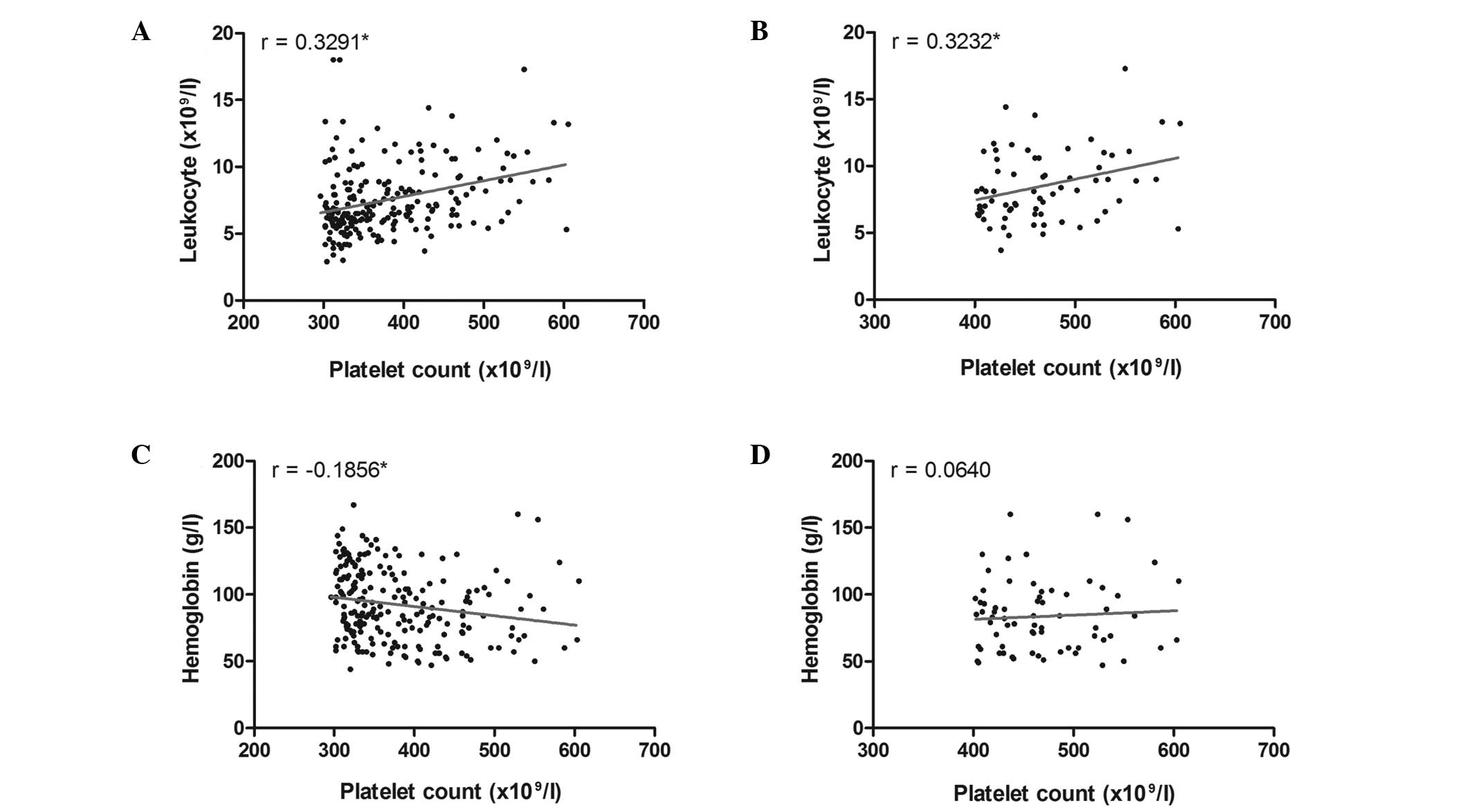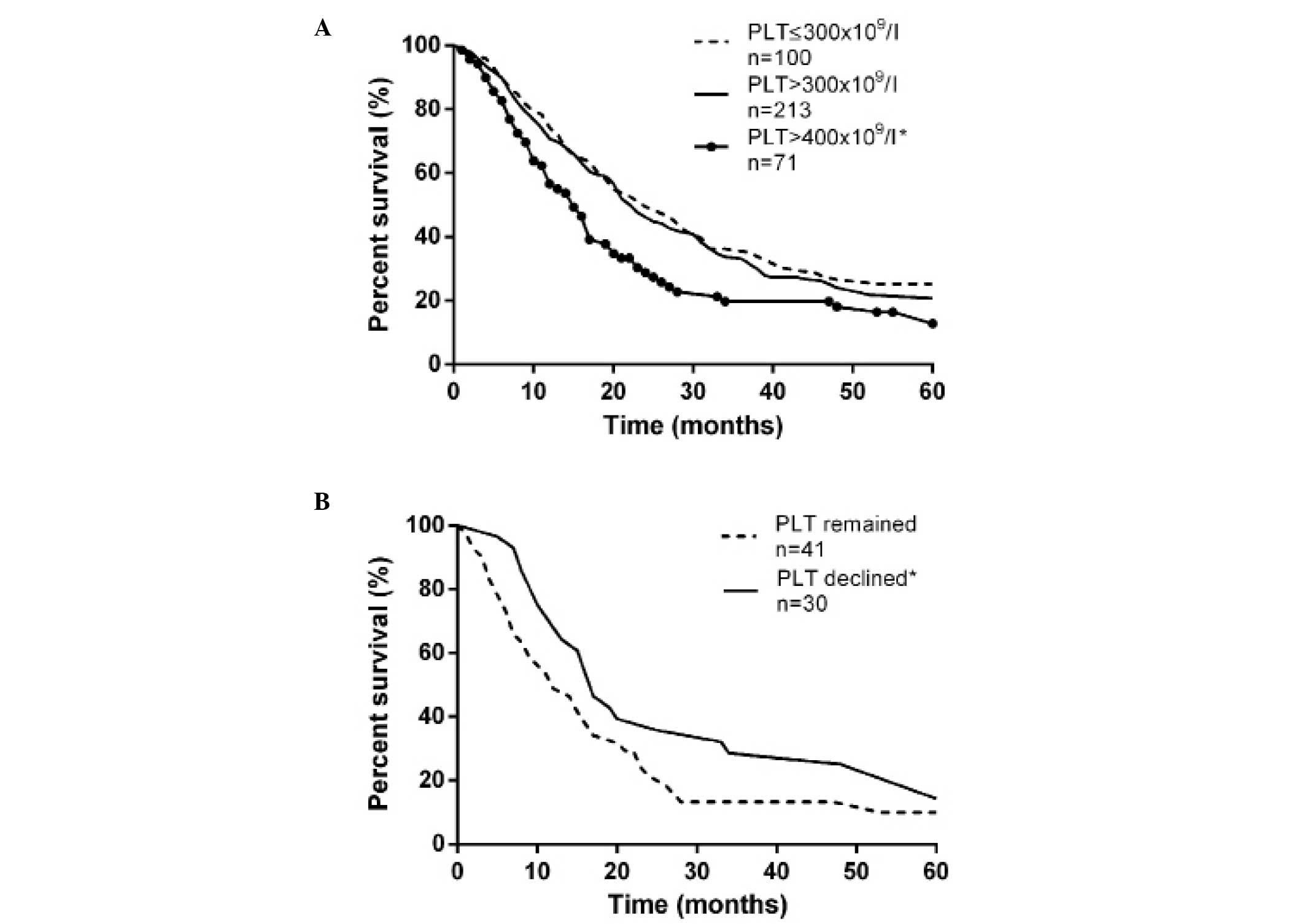|
1
|
Delhommeau F, Jeziorowska D, Marzac C and
Casadevall N: Molecular aspects of myeloproliferative neoplasms.
Int J Hematol. 91:165–173. 2010. View Article : Google Scholar
|
|
2
|
Gungor T, Kanat-Pektas M, Sucak A and
Mollamahmutoglu L: The role of thrombocytosis in prognostic
evaluation of epithelial ovarian tumors. Arch Gynecol Obstet.
279:53–56. 2009. View Article : Google Scholar : PubMed/NCBI
|
|
3
|
Huang Z, Jiang C, Zhang YM and Yao B:
Analysis of hemogram, iron staining in bone marrow and iron
metabolism in 98 patients with thrombocytosis. Chinese Journal of
Clinical Laboratory Science. 26:49–51. 2008.
|
|
4
|
Tchebiner JZ, Nutman A, Boursi B, et al:
Diagnostic and prognostic value of thrombocytosis in admitted
medical patients. Am J Med Sci. 342:395–401. 2011. View Article : Google Scholar : PubMed/NCBI
|
|
5
|
Iwasaki A, Hamanaka W, Harnada T, Maekawa
S, Enatsu S and Shirakusa T: Significance of platelet counts in
patients who underwent surgical treatment for lung metastasis. Int
Surg. 92:103–109. 2007.PubMed/NCBI
|
|
6
|
Ikeda M, Furukawa H, Imamura H, et al:
Poor prognosis associated with thrombocytosis in patients with
gastric cancer. Ann Surg Oncol. 9:287–291. 2002. View Article : Google Scholar : PubMed/NCBI
|
|
7
|
Maráz A, Furák J, Varga Z, Kahán Z,
Tiszlavicz L and Hideghéty K: Thrombocytosis has a negative
prognostic value in lung cancer. Anticancer Res. 33:1725–1729.
2013.PubMed/NCBI
|
|
8
|
Gouin-Thibault I, Achkar A and Samama MM:
The thrombophilic state in cancer patients. Acta Haematol.
106:33–42. 2001. View Article : Google Scholar
|
|
9
|
Riess L: Pathology of the blood. Arch Anat
Physiol Wissensch Med. 39:237–249. 1872.(In German).
|
|
10
|
Ferrigno D and Buccheri G: Hematologic
counts and clinical correlates in 1201 newly diagnosed lung cancer
patients. Monaldi Arch Chest Dis. 59:193–198. 2003.PubMed/NCBI
|
|
11
|
Qiu MZ, Xu RH, Ruan DY, et al: Incidence
of anemia, leukocytosis, and thrombocytosis in patients with solid
tumors in China. Tumour Biol. 31:633–641. 2010. View Article : Google Scholar : PubMed/NCBI
|
|
12
|
Aminian A, Karimian F, Mirsharifi R, et
al: Significance of platelet count in esophageal carcinomas. Saudi
J Gastroenterol. 17:134–137. 2011. View Article : Google Scholar : PubMed/NCBI
|
|
13
|
Aoe K, Hiraki A, Ueoka H, et al:
Thrombocytosis as a useful prognostic indicator in patients with
lung cancer. Respiration. 71:170–173. 2004. View Article : Google Scholar : PubMed/NCBI
|
|
14
|
Brockmann MA, Giese A, Mueller K, et al:
Preoperative thrombocytosis predicts poor survival in patients with
glioblastoma. Neuro Oncol. 9:335–342. 2007. View Article : Google Scholar : PubMed/NCBI
|
|
15
|
Nather A, Mayerhofer K, Grimm C, et al:
Thrombocytosis and anaemia in women with recurrent ovarian cancer
prior to a second-line chemotherapy. Anticancer Res. 23:2991–2994.
2003.PubMed/NCBI
|
|
16
|
Zwitter M, Kovac V, Smrdel U, Kocijancic
I, Segedin B and Vrankar M: Phase I-II trial of low-dose
gemcitabine in prolonged infusion and cisplatin for advanced
non-small cell lung cancer. Anticancer Drugs. 16:1129–1134. 2005.
View Article : Google Scholar : PubMed/NCBI
|
|
17
|
Cerutti A, Custodi P, Duranti M, Noris P
and Balduini CL: Thrombopoietin levels in patients with primary and
reactive thrombocytosis. Br J Haematol. 99:281–284. 1997.
View Article : Google Scholar : PubMed/NCBI
|
|
18
|
Soonthornthum T, Suraseraneewong V,
Kengsakol K, Wijaithum K, Kasemsan P and Prommatt S: Thrombocytosis
in advanced epithelial ovarian cancer. J Med Assoc Thai.
90:1495–1500. 2007.PubMed/NCBI
|
|
19
|
de Sauvage FJ, Carver-Moore K, Luoh SM, et
al: Physiological regulation of early and late stages of
megakaryocytopoiesis by thrombopoietin. J Exp Med. 183:651–656.
1996.PubMed/NCBI
|
|
20
|
Lidor YJ, Xu FJ, Martínez-Maza O, et al:
Constitutive production of macrophage colony-stimulating factor and
interleukin-6 by human ovarian surface epithelial cells. Exp Cell
Res. 207:332–339. 1993. View Article : Google Scholar : PubMed/NCBI
|
|
21
|
Ceresa IF, Noris P, Ambaglio C, Pecci A
and Balduini CL: Thrombopoietin is not uniquely responsible for
thrombocytosis in inflammatory disorders. Platelets. 18:579–582.
2007. View Article : Google Scholar : PubMed/NCBI
|
|
22
|
Symbas NP, Townsend MF, El-Galley R, Keane
TE, Graham SD and Petros JA: Poor prognosis associated with
thrombocytosis in patients with renal cell carcinoma. BJU Int.
86:203–207. 2000. View Article : Google Scholar : PubMed/NCBI
|
|
23
|
Tomita M, Shimizu T, Ayabe T and Onitsuka
T: Prognostic significance of the combined use of preoperative
platelet count and serum carcinoembryonic antigen level in
non-small-cell lung cancer. Gen Thorac Cardiovasc Surg. 58:573–576.
2010. View Article : Google Scholar : PubMed/NCBI
|
|
24
|
Lian L, Li W, Li ZY, et al: Inhibition of
MCF-7 breast cancer cell-induced platelet aggregation using a
combination of antiplatelet drugs. Oncol Lett. 5:675–680.
2013.PubMed/NCBI
|
|
25
|
Palumbo JS, Talmage KE, Massari JV, et al:
Platelets and fibrin(ogen) increase metastatic potential by
impeding natural killer cell-mediated elimination of tumor cells.
Blood. 105:178–185. 2005. View Article : Google Scholar : PubMed/NCBI
|
|
26
|
McCarty OJ, Mousa SA, Bray PF and
Konstantopoulos K: Immobilized platelets support human colon
carcinoma cell tethering, rolling, and firm adhesion under dynamic
flow conditions. Blood. 96:1789–1797. 2000.PubMed/NCBI
|
|
27
|
Bachelot T, Ray-Coquard I, Menetrier-Caux
C, Rastkha M, Duc A and Blay JY: Prognostic value of serum levels
of interleukin 6 and of serum and plasma levels of vascular
endothelial growth factor in hormone-refractory metastatic breast
cancer patients. Br J Cancer. 88:1721–1726. 2003. View Article : Google Scholar
|
|
28
|
Wang X, Chen X, Fang J and Yang C:
Overexpression of both VEGF-A and VEGF-C in gastric cancer
correlates with prognosis, and silencing of both is effective to
inhibit cancer growth. Int J Clin Exp Pathol. 6:586–597.
2013.PubMed/NCBI
|
















